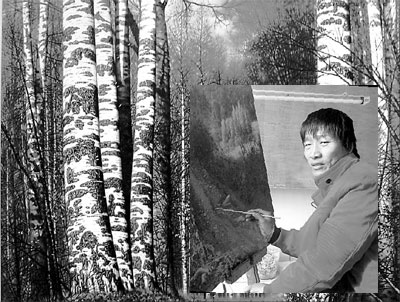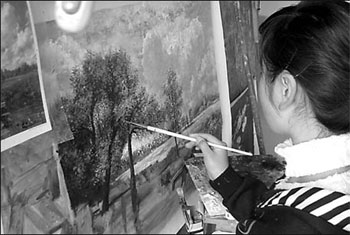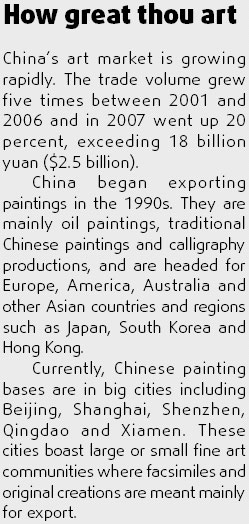Standing at the foot of the Songquan Mountains and facing a reservoir, Danigoutou village, city of Jiaonan, Shandong province, used to be an ordinary rural community, with its main activity being farming.
But it is now better known as a painting village. The village houses the Lvze Painting Academy set up by a husband-and-wife team, Xie Zhongcai and Dong Wenjie. The couple say they never imagined that the academy would one day grow into one of China's most famous reproduction bases of oil paintings when they moved there four years ago with 20 other painters, from the city of Qingdao.

The Xies used to run an art shop in Qingdao but found it hard to make a living owing to the high living costs there. So they decided to move to Danigoutou village.
"There are now 600 skilled painters working here. About 30,000 pieces of oil paintings are exported every year," says Dong Wenjie. These exports bring in a profit of $20 million annually. While farming continues to remain important, many villagers also double as models for the painters.
Xie, 39, has had no formal training in art but is gifted with a keen sense of color. He especially liked tracing paintings by Russian landscape painter Ivan Ivanovich Shishki.
Growing up in the forests of the Great Xing'an Mountain range in northeast China is a perfect catalyst for this interest. The primitive forests there helped him imbue his paintings with much realism.
"We chose this village because rampant forests around it are quite similar to those in my hometown," says Xie.
Indeed, standing in front of Xie's 3m by 5m painting of his beloved forests, one feels as if being surrounded by the trees. Besides the painting's visual force, viewers can sense the dramatic tension in the perfect combination of the grandeur and beauty of the forests and the harsh environment. This painting was picked up by a European client for US$100,000.

"Realistic paintings are always large-scale and require solid painting skills. That is why I like reproducing realistic paintings," says Xie.
"I come from the forests. I am familiar with everything in the forests such as cloudy sky, penetrating sunshine, groves of wild grass and trails and rivers slicing through the forests. My forest paintings show my love of nature."
Nowadays, Xie is concentrating more on his own creations than on copying those by others. "Xie is a talented artist. We have known him for three years now," says Edme Yann, a client from France, as he packs some oil paintings.
The couple's move from Qingdao was triggered by visits to painting markets in Beijing, Shanghai, Shenzhen and Xiamen where they discovered a huge demand for oils in Europe, America and Australia. They decided to focus on export. Dong Wenjie set up a branch in France to take charge of overseas order and sales.
The couple invited painters of various styles, including oil, Chinese and abstract painting to the village. Every painter in the village guides about 10 workers to reproduce classical oil paintings whose efforts are much sought after in countries as far as France, Germany, the United States, South Korea and Australia.

Xin Liping, 44, who is reproducing the Russian painting Oak, says: "My team reproduces more than 10 oil paintings every month. All of them are ordered by foreign clients."
"I came to the village one year ago and kept painting. All of my reproductions have been exported. I can soon have my own villa," says 56-year-old Niu Qihai who focuses on repros of original landscapes.
Walking out of his painting room, Xie stretched his tired arms and pointing to a row of villas, saying proudly: "We built these villas by ourselves through hard work."
Luo Qingmei has been here for three years. She is only 22 years old. "I have learnt a lot here," Luo says, adding that she will also try her own creations as they command a higher price. About 40 artists in the village focus on their own creations.
To develop this painting village, the city government of Jiaonan has invested about 8 million yuan (US$1.11 million) in infrastructure construction. The village now has hotels and supermarkets.
To meet the demand for painters, the Xies have set up the Lvze Painting Academy, where enrolment currently stands at 500. "In three years, we will come up to standards at a normal fine art college," says Xie.
"Our aim is to have 3,000 painters working here and develop the academy into China's No 1 painting village," says Dong.
(China Daily February 27, 2008)